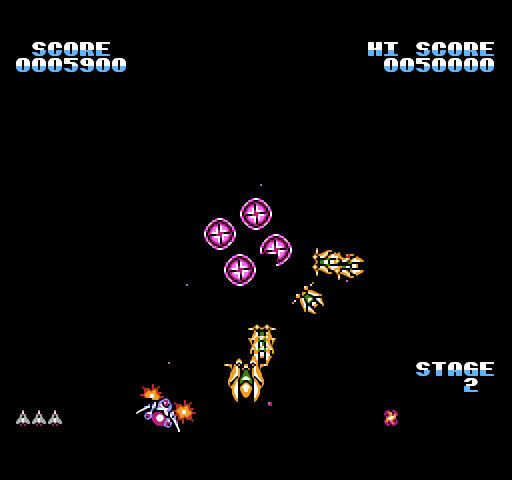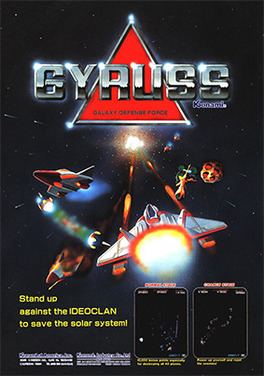9.8 /10 1 Votes
Programmer(s) Toshio Arima Composer(s) Masahiro Inoue Initial release date 1983 Genre Shoot 'em up | 4.9/5 Emuparadise Artist(s) Hideki Ooyama Cabinet Upright or cocktail | |||||||||||||||||||||||||||||||||
 | ||||||||||||||||||||||||||||||||||
Mode(s) Up to 2 players, alternating turns Arcade system CPU2x Zilog Z80, Motorola 6809, Intel 8039Sound5x AY-3-8910, DAC Similar Centuri games, Shoot 'em up games | ||||||||||||||||||||||||||||||||||
Retro arcade gyruss
Gyruss (ジャイラス, Jairasu) is a fixed shooter arcade game designed by Yoshiki Okamoto and released by Konami in 1983. Gyruss was initially licensed to Centuri in the United States for dedicated machines, before Konami released their own self-distributed conversion kits for the game. Parker Brothers released contemporary ports for the Atari 2600, Atari 5200, Atari 8-bit family, ColecoVision, and Commodore 64. An enhanced version for the Family Computer Disk System was released in 1988, which was released to the North American Nintendo Entertainment System in early 1989.
Contents

The gameplay is similar to that of Galaga but presented in a forced 3D perspective, with the player's ship facing into the screen and able to move around the perimeter of an implicit circle. Stars come into view at the centre of the screen and fly outward, giving the impression of the player's ship moving through space.

Gyruss is the second and last game Yoshiki Okamoto designed for Konami, after Time Pilot. Due to pay disputes, he was fired after the release of this game, and soon joined Capcom, where he would write 1942 and produce Street Fighter II.

The game's background music is an electronic, uptempo arrangement of J. S. Bach's Toccata and Fugue in D minor, BWV 565; this particular track is similar to "Toccata," a rock arrangement by the UK-based instrumentalist group Sky. Gyruss is notable for using stereo sound, which according to the bonus material for Konami Arcade Classics, was achieved by utilizing discrete audio circuits.

Gyruss was released in both upright and cocktail cabinets.
Arcade game gyruss 1983 konami
Gameplay

The majority of enemies are spaceships, which must be destroyed to complete a level. They appear either from the centre of the screen or from one of the edges, and move in swirling patterns. They can shoot the player's ship or destroy it by contact. They hover near the centre of the screen after completing their deployment pattern, and occasionally fly outwards and shoot at the player. If not destroyed by the player, the enemy ships gradually fly away one by one.
There are also several other types of enemies: satellites, asteroids, and laser beam generators. These appear intermittently and soon disappear of their own accord if not destroyed by the player.
Satellites materialise in a group of three just in front of the player after the ordinary enemy ships have finished deployment. They gyrate in small circles and shoot at the player. If the player has the basic weapon when the satellites appear the middle one will be a sun-like object. If destroyed, the player's ship gets a better weapon. If the better weapon has already been gained then all satellites are identical.
Asteroids fly straight outwards from the centre of the screen at regular intervals. They cannot be destroyed, but a small points bonus is given for shooting at them.
Laser beam generators occasionally fly straight outwards from the centre of the screen. They consist of two generator segments with a laser beam between them; destroying either generator deactivates the beam. The player's ship is destroyed by contact with either the generators or the beam.
The player begins the game "2 WARPS TO NEPTUNE". After completing each level, the player is one warp closer to a planet. Each time a planet is reached, the player's ship is seen flying towards it and then a short bonus round is played, where the player can shoot enemy ships for bonus points without worrying about being destroyed by them. After reaching Neptune, the player is then three warps from Uranus, and progresses through Saturn, Jupiter, Mars, and finally Earth, taking three warps to reach each planet. Stage one and every 10th stage thereafter the enemies do not fire on the player when entering the screen.
After completing Earth's bonus stage, the player must travel through the very fast "3 WARPS TO NEPTUNE" level before returning to the start of the game.
Re-releases
Gyruss has a nearly perfect port (minus the attract mode) in the compilation game Konami 80's Arcade Gallery, released for both the arcade and PlayStation (also known as Konami 80's AC Special in western arcades and Konami Arcade Classics in the North American PlayStation version).
There is a faithful implementation in Konami Collector's Series: Arcade Advanced for the Game Boy Advance.
The Konami Live! Plug and Play PC controller includes an emulated Gyruss with an online scoreboard, as well as five other Konami titles.
On April 18, 2007, the game was released on Microsoft's Xbox Live Arcade service with optional enhanced graphics and online high-score leaderboards.
Dance Dance Revolution Ultramix 2 contains a remix of the Gyruss music as a playable song.
Clones
Clones exist as one of the minigames found in various convenience stores featured in the game Grand Theft Auto: San Andreas, and another as a minigame in Contra: Legacy of War.
NES/FDS remake
Gyruss was remade for the Family Computer Disk System in Japan, and later the Nintendo Entertainment System in North America, released by Konami's subsidiary Ultra Games. In these versions of the game, the core gameplay is still largely the same, but there are several major revisions. The game was well received in North America. Revisions include:
This version of the game was included in the Majesco TV Game Konami Collector's Series: Arcade Advanced. This was the also the version released for Japanese mobile phones in 2004.
